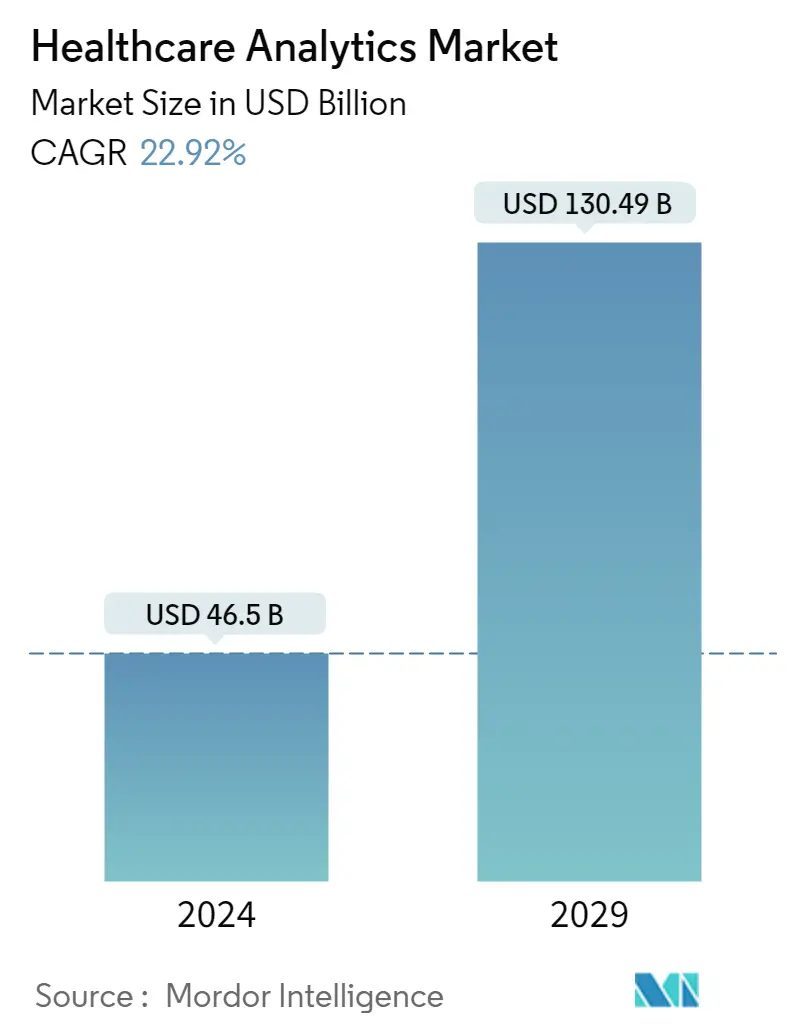Market Size of Healthcare Analytics Industry

| Study Period | 2021 - 2029 |
| Market Size (2024) | USD 46.50 Billion |
| Market Size (2029) | USD 130.49 Billion |
| CAGR (2024 - 2029) | 22.92 % |
| Fastest Growing Market | Asia Pacific |
| Largest Market | North America |
Major Players.webp)
*Disclaimer: Major Players sorted in no particular order |
Need a report that reflects how COVID-19 has impacted this market and its growth?
Healthcare Analytics Market Analysis
The Healthcare Analytics Market size is estimated at USD 46.5 billion in 2024, and is expected to reach USD 130.49 billion by 2029, growing at a CAGR of 22.92% during the forecast period (2024-2029).
The COVID-19 pandemic impacted the public health systems in many countries. For instance, the healthcare industry was burdened with pandemic crisis management. Furthermore, worldwide lockdowns were imposed to curb the viral outbreak. This, in turn, led to a shortage of healthcare staff across the globe. Similarly, the healthcare prescriptive analytics market was impacted by the viral outbreak. For instance, the worldwide lockdowns led to a rise in healthcare IT technology and remote health monitoring. In addition, the adoption of predictive and prescriptive analysis software increased, which was employed in estimating the number of COVID-19 cases and deaths. Furthermore, the software was also rapidly adopted during the viral outbreak to estimate the number of resources needed in the hospital, such as hospital patient beds, ICU beds, the supply, and demand of personal protective equipment (PPE), and others. Companies have also released new healthcare prescriptive analytics software to combat COVID-19.For instance, the COVID-19 Index, developed by the National Minority Quality Forum (NMQF), is a predictive analysis tool that can assist physicians in planning for future COVID-19 outbreaks. The software can help avoid epidemics, cure diseases, cut expenditures, and analyze specific health data from a community or an individual. Hence, increased demand during COVID-19 had a positive impact on the studied market. However, the growth is expected to gradually stabilize post-COVID-19.
The major factors driving the growth of the market include the rise in the integration of big data in healthcare, the growing need for increased efficiency in the healthcare sector, and the increasing demand to curtail healthcare costs. To predict the future, we need data from the past as well as the present, and analyzing the data being generated at the same time makes this process complex and machine-intensive. Additionally, unnecessary healthcare costs can also be reduced through analytics. For instance, according to the Organisation for Economic Co-operation and Development (OECD), health spending per capita will grow at an average annual rate of 2.7% across the OECD and will reach 10.2% of GDP by 2030. In addition, population health management (PHM) is the analytic utilization of data from many sources, and the surge in the adoption of PHM also drives the growth of the studied market. For instance, in August 2022, RTI Health Advance will bring together the power of healthcare analytics, digital health, and patient experience to help provider and payer organizations build PHM programs.
Thus, the abovementioned factors are impacting the market growth of the Healthcare Analytics market. However, the cost and complexity of software, data integrity and privacy concerns, and a lack of properly skilled labor are the factors expected to restrain market growth.
